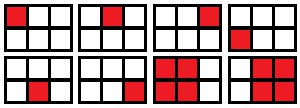标签:
Spongebob is already tired trying to reason his weird actions and calculations, so he simply asked you to find all pairs of n and m, such that there are exactly x distinct squares in the table consisting of n rows and m columns. For example, in a 3?×?5 table there are 15 squares with side one, 8 squares with side two and 3 squares with side three. The total number of distinct squares in a 3?×?5 table is 15?+?8?+?3?=?26.
The first line of the input contains a single integer x (1?≤?x?≤?1018) — the number of squares inside the tables Spongebob is interested in.
First print a single integer k — the number of tables with exactly x distinct squares inside.
Then print k pairs of integers describing the tables. Print the pairs in the order of increasing n, and in case of equality — in the order of increasing m.
26
6 1 26 2 9 3 5 5 3 9 2 26 1
2
2 1 2 2 1
8
4 1 8 2 3 3 2 8 1
In a 1?×?2 table there are 2 1?×?1 squares. So, 2 distinct squares in total.

In a 2?×?3 table there are 6 1?×?1 squares and 2 2?×?2 squares. That is equal to 8 squares in total.

#include <cstdio>
#include <iostream>
using namespace std;
struct thing
{
long long x,y;
} ans[1000000];
long long a,n,tot,same;
int main()
{
cin.sync_with_stdio(false);
cin>>n;
long long i = 1;
while(true)
{
long long b = (i-1)*i*(2*i-1)/6 - i*i*(i-1)/2;
if(b >= n) break;
long long k = i*(i+1)/2;
if((n - b) / k < i) break;
if((n - b) % k == 0)
{
ans[++tot].x = i;
ans[tot].y = (n - b) / k;
if(ans[tot].x == ans[tot].y) same++;
}
i++;
}
cout<<2*tot-same<<endl;
for(int i = 1;i <= tot;i++) cout<<ans[i].x<<" "<<ans[i].y<<endl;
for(int i = tot;i;i--)
if(ans[i].x != ans[i].y)
cout<<ans[i].y<<" "<<ans[i].x<<endl;
} Codeforces Round #332 (Div. 2) D. Spongebob and Squares
标签:
原文地址:http://blog.csdn.net/u014258433/article/details/51371954